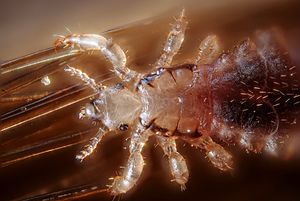
- This is in experiment in a fact-based article structure, initiated by Chriswaterguy. Feel free to join, following the same ideas, or leave coments on the talk page.
Head lice do not appear to be vectors of human disease. On the other hand, many lice-killing pesticides are poisonous, so non-toxic methods for prevention and elimination are preferable. Methods which are safe (don't involve poisons) are particularly suitable for prevention when cases of head lice are known to exist.
For this approach there are some key facts one should know.
Lice cannot survive without blood for more than 2 days. So:
- The clothing and bedding that carries risk of spreading the lice is that worn in the last two days. This should be washed and sealed for 2 days
Nits (louse eggs) survive much longer (30 days?[verification needed]). - however these are generally laid in hair so the risk of clothing carrying nits is smaller. Some may have rubbed off onto items such as pillows and hats, though. So:
- items such as pillows or hats can be either dry cleaned (if very urgent) or sealed and stored for 30 days. A shorter time may work, but 30 days should be safe.[verification needed]
Nits within 3mm (1/4 inch) of the scalp are the most likely to survive and become nits. So:
- When manually removing nits (by hair or comb) the priority is to get the nits away from the scalp - though it is best if they are removed completely.
Effects of oil on lice: Oil can suffocate lice,[verification needed] and nits are reportedly easier to remove when the hair has been soaked in oil.[verification needed][1]
- Drench the hair in oil, covering with a plastic shower cap or cling wrap. Leave this for a long period (overnight is suggested).
Methods:
- Combing
- Adding pure conditioner to the hair (no water) and combing out.
- Using a metal nit comb. As this is uncomfortable, using a plastic comb very frequently and a metal comb every few days may be a good compromise, depending on the seriousness of the infestation.
- Manual inspection and killing with fingernails.
Alternative pesticides[edit | edit source]
While natural treatments are not always safer than artificial ones, most are. However, they are also less toxic to the lice, meaning that they cannot be relied on by themselves. Also, multiple treatments may be needed.
- Neem is a common folk remedy against maggots and head lice. (Neem A Tree for Solving Global Problems 9 and Neem A Tree for Solving Global Problems 11)
- Mix 1 part apple cider vinegar, 1 part rubbing alcohol, and a small portion of cayenne pepper, and soak the hair completely. Wrap the hair in a plastic bag for at least 3 hours, or sleep with it on overnight. Follow up by washing your bedding and clothing the day after. Repeat about 5 days later to get the eggs that have hatched. Alternate with Nix or other conventional delousing agent if process does not work alone. Worked for me, without the Nix, and I have dreadlocks (6 months of being lice free)!!!!!!!!!!!!!!!!!!!!!
Convontional treatments[edit | edit source]
OTC (over the counter) medications:
- Pyrethrins - natural extracts from the chrysanthemum flower, onften used in combination with other pesticides. Only kills crawling lice, not unhatched nits. A second treatment is recommended in 7-10 days to kill any newly hatched lice. Treatment failures are common.[2]
- Permethrins - synthetic variations of pyrethrins
By prescription (in the USA and many other countries) - these should be used with caution:
Notes[edit | edit source]
- ↑ Virgin coconut or olive oil have been recommended for their natural insecticidal properties - however it seems reasonable to assume that the suffocation is the main factor at work and any oil should work. Is a more viscous oil better?[expansion needed]
- ↑ Treating Head Lice Infestation Fact Sheet - Centers for Disease Control and Prevention (US government)